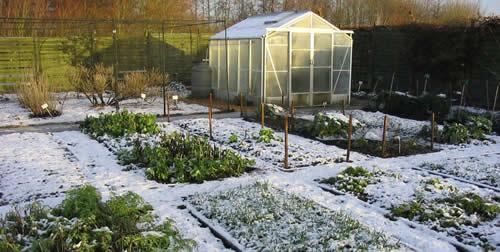There’s always a point in winter, usually sometime between the beginning and middle of February, that I become tired of waiting, tired of being inside, tired of being… cold. This does thankfully seem a natural sequence, as this is generally a good time for me to get my seed starting equipment together, check my lights and heat mats are in good working order, and start some of my cool weather seedlings. Starting seeds indoors is a right of spring for all gardeners, but there are also many things you can plant outside as early as the next snow thaw.
Winter Garden
Some seeds come with instructions to “stratify” which can be confusing at first introduction. Stratification refers to a period of time where a seed needs to have cold, moist conditions to germinate. Mother Nature provides us with these conditions in the form of winter, and it seems silly to me, as someone who likes to work smarter not harder, to not take advantage of this when possible. The main downside of going au natural is lack of control. Your precious seeds can be chomped by birds, or a quick snow melt or heavy spring rain could wash the seeds somewhere you don’t want them. That said, it is still one of my favorite ways to get a jump start on planting.
You can replicate the natural stratification process by rolling your seeds in a moist, well-wrung paper towel or cloth, tuck that into a zip top bag and put the whole caboodle into the fridge for 1 to 8 weeks depending on the seed.

Why is stratifying important?
That’s an easy one. Cold, moist conditions break down the hard seed coat and, when the warmth of spring comes, triggers germination. This works best on seeds that are cold hardy biennial and perennials, plants that are generally first to come up in spring, and the last to die back when the frosts of Autumn come.
Good choices: Arugula, Beet, Calendula, Chives, Cress, Echinacea, Lavender, Lupine, Mache, Milkweed, Onion, Poppy, Sage, Spinach, Swiss Chard.
Poor choices: Large seeds like peas, beans and squashes. Any tender annuals.
You can sow your winter seeds anytime in winter up until about a month before spring, but I generally like to wait until the end of January, just to minimize risk to the seed. Choose a spot you know to be free of weeds, and make sure you mark your planting spot either with markers right in the ground or in your garden journal. If there’s still snow on the ground, move the snow away from your chosen spot and sprinkle your seeds, aiming for 2” to 4” spacing, and cover your seeds with about 1/4” of soil to combat seed shifting. In spring, when your seedlings emerge, thin them to give your plants the room the deserve to spread and grow. In Eliot Coleman’s book Four Season Harvest, he has a great section on winter sowing that goes into a great deal more depth.
I hope this inspires you to get out and plant some seeds, and gives you hope that winter WILL end soon. Just remember: We can make it. 17 more days…
Are there any seeds you plant in winter that I left off the list? Share in the comments so we can all learn!
| |
Article Written by: Angie Lavezzo |
|
About the Author: Angie Lavezzo is the former general manager of Sow True Seed. Beyond her professional role at Sow True, Angie's passion for gardening extends into personal hands-on experience, fostering plants and reaping bountiful harvests. |



